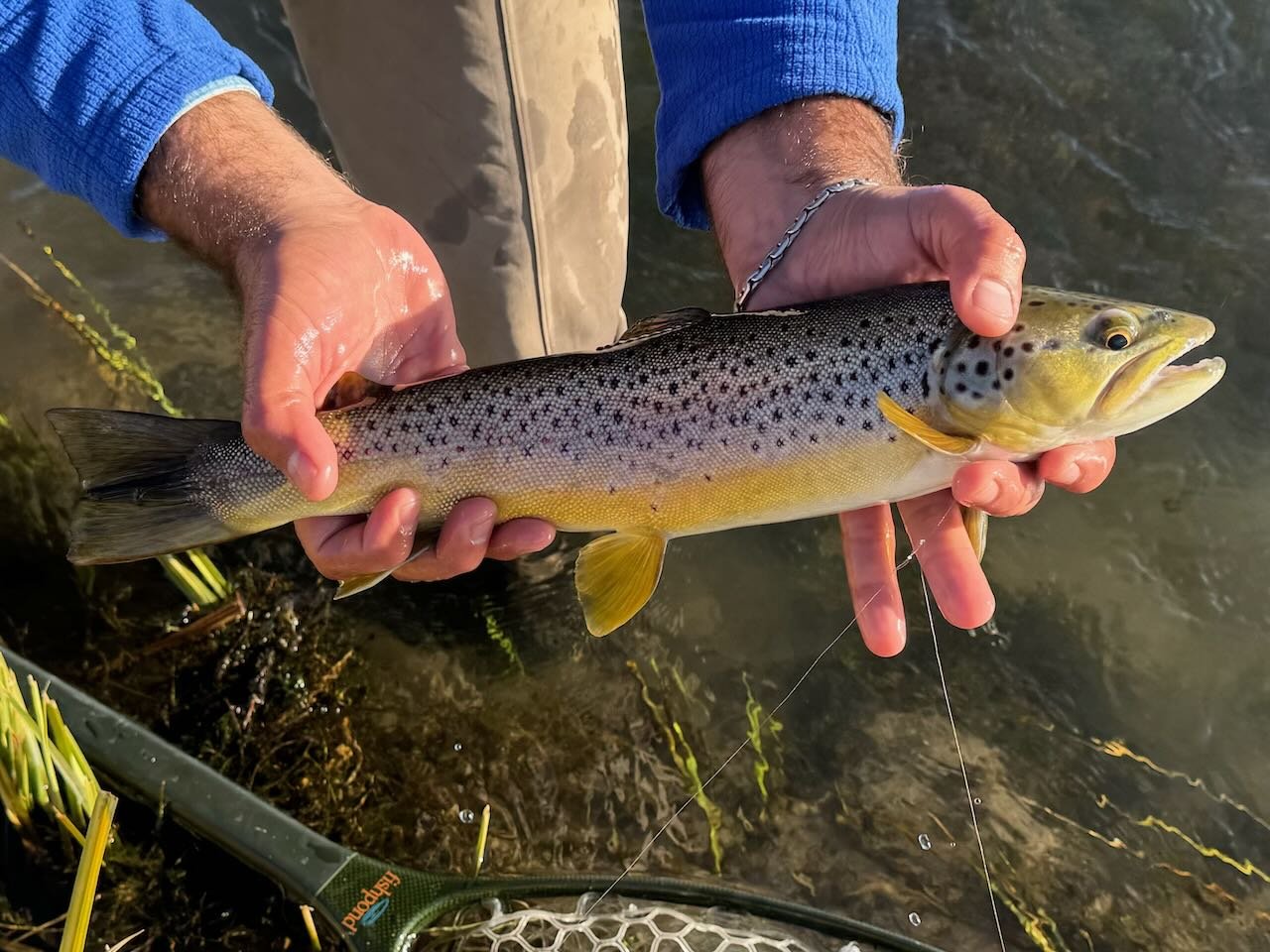Winter storms are hitting the Eastern Sierra bringing winds and snow to the high country and snow flurries and rain in the Owens Valley. Access to upper elevation waters will be determined after the storms clear and fly fishers venture out on the dirt roads now covered in six to 18 inches of snow. Be careful when driving on snow covered roads. Getting stuck in the snow is no fun and can be costly if you have to call an off road recovery crew like Frosty Four Wheeler. Fish are feeding on mayflies, midges and caddis. Nymphing has been the most consistent method of fly fishing the waters of the Eastern Sierra. Fall is a great time to target trophy trout with streamers in streams of the Eastern Sierra that are now open to catch and release fishing.
Fall and winter is a great time to be fly fishing the waters of the Owens Valley like the wild trout section of the lower Owens River.
Lower Owens River
Wild Trout Section:
With flows down to 125 CFS and rainbows and brown readily feeding on nymphs now is the time to be fly fishing on the lower Owens River. Indicator nymphing or Euro nymphing with size 18 olive quilldigons, size 18 bead head flash back pheasant tail nymphs, size 16 SOS nymphs and size 20 zebra or tiger midges is producing the wild trout. Methodically covering all the water with the right amount of weight is the key to being successful. Wading the river is giving fly fishers access to spots not accessible from the banks at higher flows. Summer growth of stream side vegetation is hampering fly fishers access to the stream banks. Cows and the impact of fly fishers is needed to beat down the vegetation and open up pathways to the river. At the right time and right section of the river trout are feeding on the surface on Adams parachutes in size 20, blue wing olive parachutes in size 20 and size 20 elk hair caddis.
Andrew Heine nymphed under an indicator to take several wild brown trout in the wild trout section of the lower Owens River.
Hot Creek
Interpretive Site:
It is yet to be determined if the road into Hot Creek is accessible as it is still snowing at the time this is being written. Before the storm the blue wing olive hatch was bringing the trout to the surface. Fishing with blue wing olive parachutes in size 20, Adams parachutes in size 20 and sparkle duns in size 20 is fooling the surface feeding trout. Nymphing after the storm will be producing trout if the blue wing olive hatch does not happen. For nymphs fish with size 18 olive quilldigons, size 16 SOS nymphs, size 16 hot spot pheasant tail nymphs and size 18 bead head flash back pheasant tail nymphs.
Rainbow trout from the canyon section of Hot Creek are feeding on nymphs fished under a dry fly.
Hot Creek
Canyon Section:
This is a great time to by fishing a nymph under a dry fly as your indicator. I like using a size 16 Adams parachute, size 14 stimulator and a mini Chernobyl ant as my indicator fly. I attach 24 to 36 inches of 5X fluorocarbon tippet to the bend of the dry fly with a clinch knot. I attach a size 20 zebra or tiger midge, size 18 bead head flash back pheasant tail nymph, size 18 SOS nymph and a size 18 olive quilldigon to catch the wild brown and rainbows of Hot Creek Canyon. Key to success is floating this rig in the open water sections in and around the weed beds. Deeper holes are always a great spot to work the nymphs through.
The brown trout run is just about done on the upper Owens River.
Upper Owens River
Above Benton Crossing Bridge:
When the skies clear and fly fishers venture out to the upper Owens River it will be determined if the roads are drivable or if it is time to be parking at Benton Crossing Bridge and walking, snow shoeing, cross country skiing or snowmobiling into the river. The trophy rainbow trout are in the river system and feeding on nymphs and streamers. This is not a quantity fishery, but a quality fishery with one to three trout above 18 inches being caught by anglers that know how to work the river. Fly fishers covering lots of deep holes, deep runs and cut banks are finding trophy trout willing to take their properly presented flies. I like fly fishing a Euro rod with three flies. My two trophy trout producing patterns are a size 12 stoner nymph and a size 12 green/gold Prince nymph. My third fly is either a size 16 hot spot pheasant tail nymph or a size 18 olive quilldigon which is there to entice the smaller resident fish. Fishing streamers downstream along the cut banks or in the deep slots or pools will produce the trophy trout. Pulling streamers requires covering lots of water to get a few trophy trout to whack at your flies.
The leaves are dropping quickly and nymphing in Bishop Creek Canal is producing stocked rainbows and wild brown trout.
Bishop Creek Canal
Behind Bishop Veterinary Hospital:
The water is low and the trout are spooky, but fly fishers are catching trout nymphing the canal. Working the deep holes, and fast runs allows fly fishes to approach the trout without spooking them. Size 18 bead head flash back pheasant tail nymphs, size 16 bead head flash back gold ribbed hare’s ears, size 16 SOS nymphs and zebra or tiger midges in size 18 are the flies that are producing the wild brown trout and holdover rainbow trout.





